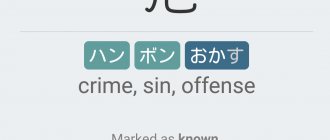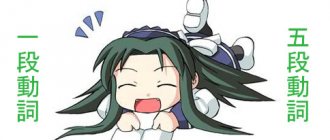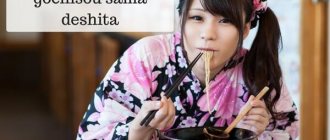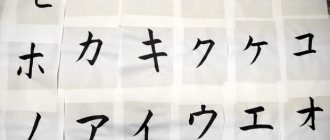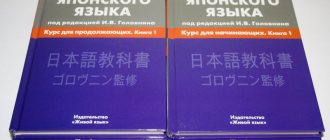What textbooks are best for learning Japanese? Let's choose the best textbook.
There are many guides for learning Japanese. And if you're just starting to learn Japanese, you may have an important question: "Which tutorial should I go for?" Today I want to review textbooks and manuals that I myself have encountered, that I have directly studied, or that I use to teach in online courses.
Japanese textbooks. What are they?
First of all, textbooks can be divided into two categories:
- Russian textbooks,
- Japanese textbooks.
Japanese textbooks more because they have more real, lively dialogues and texts, words that are closer to reality. In any case, it is very important that textbooks (no matter whether they are Japanese or Russian) include Japanese authors.
Russian textbooks are often more emotionally comfortable. For example, in the fact that everything is explained in your native language. And if you are bad with other languages, Russian textbooks will be more convenient for you. Another advantage of Russian textbooks is a clear explanation of grammar. Because in a foreign language, the explanation of grammar may not be clear.
So, in fact, I have a lot of textbooks. I will probably prepare a separate review for each textbook. Now I will try to briefly describe the pros and cons of each textbook, and read in more detail in the following issues.
JAPANESE FOR CHILDREN
So where to start? And we started, of course, with Japanese characters! Why else should you learn Japanese? And here are the first of them: the sun and the tree. We show you how to draw them, we draw them. It is important that the child follows the drawing sequence - this is more important at the initial stage than maintaining the proportions of the drawing.
We explain that the Japanese word hi (day, sun) is written with a sun, and the Japanese word ki (tree) with a tree, but at the same time we remember that these hieroglyphs have their own separate names: the hieroglyph for sun is called “NITI”, and the hieroglyph for dervo is called “MOKU” ", as well as "BOKU".
When asked why this is so, we tell you that the Japanese once loved the Chinese very much and took their hieroglyphs and began to write down their words with them, but they tried to leave their Chinese names to the hieroglyphs. For what? Yes, at least so as not to get confused in them, because there are so many of them! - such an explanation is quite enough for a start, although a dozen more explanations can be given if the child is not satisfied with this
Russian textbooks of the Japanese language
Textbook of the Japanese language edited by I.V. Golovnina
Let's start with the textbook that I used to study at RUDN (Peoples' Friendship University). I.V.’s textbook. Golovnina . It has 4 parts: for beginners and intermediate.
Pros of this textbook:
- detailed explanation of grammar and many grammatical nuances,
- great attention to vocabulary acquisition and the study of hieroglyphs.
Of the minuses:
- This is explained in scientific terms and to an unprepared person this explanation may seem quite difficult at first.
- In addition, the texts themselves are already morally outdated. Here you can find texts about the revolution in France, about engineers, and, accordingly, they are very divorced from the reality of the Japanese language.
Those. This textbook is good for learning grammar, but I would recommend using other textbooks.
Golomidova M., “Japanese for children”
The next textbook is the textbook “Japanese for Children” from Marina Golomidova. I used this textbook when I was 16 years old. I had just developed an interest in the Japanese language, and I was making my first independent attempts to learn it. I would not say that this is a professional textbook and you will get far with it.
But the advantages of this textbook are that everything is explained here very simply, in simple words, for children. Here you can draw all sorts of different pictures.
Nechaeva L.T., “Japanese language”
Another textbook is the Japanese language textbook by L.T. Nechaev. It is used in many courses and also in institutes. It also has several parts for beginners and intermediates. Here, for example, phonetics for hieroglyphs are given very well, there are words, texts, even a disk for it. There are a lot of exercises, which is useful for practicing grammar. The grammar itself is very well explained. But the texts here, as in many Russian textbooks, are divorced from life. And also the selection of hieroglyphs is not always successful.
Sheftelevich N.S. and Strugova E.V., “Reading, writing, speaking Japanese”
The next Russian textbook is the textbook by N.S. Sheftelevich. and Strugovoy E.V. “We read, write, speak Japanese.” It has several parts. There are even copybooks. Also a good textbook for studying grammar: there are exercises, there are hieroglyphs, various texts, dialogues, a disk. In principle, a very good textbook.
What programs and textbooks can you use to learn Japanese?
Greetings, friends! Last time I promised that I would talk about textbooks and programs that will help you learn Japanese on your own. You must keep in mind that self-discipline is necessary to learn the language on your own, because no one controls you or checks how you did your homework, so if you doubt your abilities, it is better to immediately contact a specialist, look at the Japanese language school page.
I think that no one even doubts that when you are led by the hand, learning everything, even the Japanese language, is much easier and simpler, plus in the process of such learning, like-minded people appear with whom you can communicate and discuss issues. Sensei will answer all your questions and help you on the difficult path of mastering the Japanese language.
But at the same time, a much larger part of those who are interested in Japan prefer the path of independent language learning; some on this path very quickly leave the distance; others, by diligently studying, achieve their goal.
There are a lot of textbooks for learning Japanese, most of them written by Russian teachers. I will simply list these textbooks, I will not give a description, since I myself studied and am studying using the Minna No Nihongo textbook. If you do not know Japanese and you do not have a mentor who could explain complex issues, then preference should probably be given to textbooks by Russian authors.
- Nechaeva L.T. “Japanese for Beginners” – 2 volumes
- Golovnin I.V. "Japanese language textbook. Course for Beginners" (4 volumes in total, 2 for beginners and 2 more for continuing education)
- Strugova E.V., Sheftelevich N.S. “Reading, writing, speaking Japanese” - 2 volumes
The listed textbooks are considered the most popular (among the textbooks of Russian authors). For self-study, they are more comfortable and accessible, since all the grammar is explained in Russian. But what is a plus is also considered a minus, since Russian authors adapt the Japanese language to our concepts of language and use terms that are not in the Japanese language. Also, some textbooks are outdated, in particular Golovnin I.V., published in 1978. There is a later edition of this textbook from 2005 (2011), but the essence has not changed by and large. If you do not take into account the texts of the textbook, then grammar can be studied according to Golovnin.
Textbook by Nechaeva L.T. used for studying in universities, it covers grammar very well and has a lot of practical exercises, which is very important for consolidating the material. Using the textbook “Japanese for Beginners,” you can begin to learn the Japanese language with zero knowledge; the textbook begins with a detailed study of kana and gradually moves on to more complex elements. All grammar and explanations are given in Russian.
Textbook E.V. Strugova, N.S. Sheftelevich is also recommended by many for independent study. The textbook contains the Japanese syllabic alphabet - Hiragana and Katakana and copybooks for practical exercises, the order of writing hieroglyphs and a lot of practical material. The textbook is structured and logical.
Among the textbooks by Japanese authors, the most popular textbook is Minna No Nihongo; I’ll tell you more about the textbook later.
If the presence of kana with copybooks is considered a plus in Russian textbooks, then for me this was not a problem. Yes, in Minna No Nihongo the material from the first page is presented as if you already know the language (the very basics), but this should not scare you. Although, after looking at the textbook, even with a Russian translation, I simply closed it, deciding that this was a book for aliens and went to get used to Japanese speech, which I wrote about here. But from the second approach, the textbook and the material presented in it no longer seemed so scary. The main thing is systematic and methodical study of the Japanese language. I can say from the bottom of my heart that learning Japanese is really very interesting.
My learning of Japanese began with:
- Studying hiragana, which I took from Wikimedia. The file is quite visual, understandable and accessible, it shows the sequence of features, the pronunciation is indicated, you can write syllables on plain paper, you don’t need to have copybooks for this. But for those interested, a little later I will indicate a resource from which these recipes can be downloaded. The Hiragana alphabet (tables) can also be viewed and, if desired, downloaded here. This is educational material from NHK WORLD website.
- Then I began to study grammar using the textbook Minna No Nihongo (in the Russian version), without fail studying all the words that were given in the lessons, skipping only those written in hieroglyphs.
- At a certain stage, I realized that ignorance of katakana interfered with further study, so I had to master it too. Ideally, it is better to learn katakana immediately after hiragana. Katakana (table) with the order of writing strokes can be downloaded here.
- Online Japanese language lessons on the international website NHK WORLD turned out to be very useful and effective for me. Lessons last 10 minutes and are accompanied by audio texts voiced by native speakers with explanations from Russian speakers. The dialogues offered for study are very close to everyday communication. By learning dialogue, you will be able to speak and understand Japanese at the most basic level. In addition to the audio part, there is a lot of text material, grammar, words to study, quizzes, dictionaries, alphabet, both in audio and in text, which can be downloaded for practical work. Additionally, all materials offered on the site can be downloaded to your computer for independent study.
- Also, my constant companion is an audio dictionary, which probably contains 200-300 words, I don’t know where it came from, I found it on VKontakte. And every time I come home after work, between tasks I put on headphones and repeat the words. You can also listen to Japanese language lessons from NHK WORLD. I like this way of learning Japanese because it allows me to combine some mechanical work (cooking dinner) with learning.
- I also purchased an audio dictionary of Japanese words from Daria Moinich. The words are pronounced by a native Japanese speaker with repetition syllable by syllable, very convenient for those who have just started learning the language. Additionally, Daria sends a paper (electronic) format of the words being studied, which is also very important for learning; the words are written in hiragana and kanji. The dictionary is designed for beginners and contains a small number of words.
There are still many really useful and high-quality resources on the Internet that will help you learn Japanese on your own, so come visit often, we will get to know them together as the material becomes more complex.
Good luck and perseverance, friends, both in self-study and with a teacher, be it online courses, offline courses or individual training. All methods are good, because the main thing in this is YOU, your desire to learn the language.
Japanese language textbooks from Japanese authors
Minna no nihongo
And yet, I prefer Japanese textbooks , which I will also tell you about now. The textbook that I like best and that I use in online courses is the textbook "Minna no nihongo". What I like about it is that:
- It has a lot of different add-ons. For example, an essay writing supplement.
- There is a separate book on hieroglyphics.
- There is a book for reading, there is a lot for listening.
- There is even a grammatical commentary in Russian.
Thus, thanks to these additions, you can develop writing characters, reading, listening - and many other skills important for the Japanese language. Moreover, all texts in this textbook are as close to reality as possible.
Genki
And another good textbook used in language schools in Japan is “Genki”. It also has many expansions and editions, just like Minna no nihongo. And I can recommend it to you too.
That's all. I will try to prepare separate detailed reviews for each textbook. So you can get to know them in the future.
What textbooks do you use or have you used? Which ones do you like best?
You can go through one of the topics covered in the textbooks with us, namely, cases in the Japanese language. And if you want to continue studying Japanese, write to and find out how to get to our advanced course.
TEACHING CHILDREN JAPANESE LANGUAGE
After several days of active pressure from the little one (4th grade) with a request to teach her Japanese, I had to meet the person halfway and try to start unobtrusively teaching her Japanese. In principle, why not?
Two years ago, she demanded Arabic - as a result, her knowledge of a few words and the alphabet created a stunning sensation in Egypt. But... there simply wasn’t enough time for further advancement: the little man is a star in music, lives actively... Even before that, we had experience of getting to know English, but for some reason she didn’t like it, although the eldest, on the contrary, after my “English lessons”, to which we devoted half an hour on summer evenings before the fourth grade, it went so far that now in two languages (English and French) it wins Olympiads, and all-Russian ones at that :) Well, well.. now Japanese...
OK. It wouldn’t require much effort on my part, so I decided: a little at a time, playfully. Why not. If I don’t get tired of sharing the progress of the operation here (sometimes I don’t have enough time to put out the usual materials, let alone burden myself with it), then, you see, maybe someone will find it useful too.

